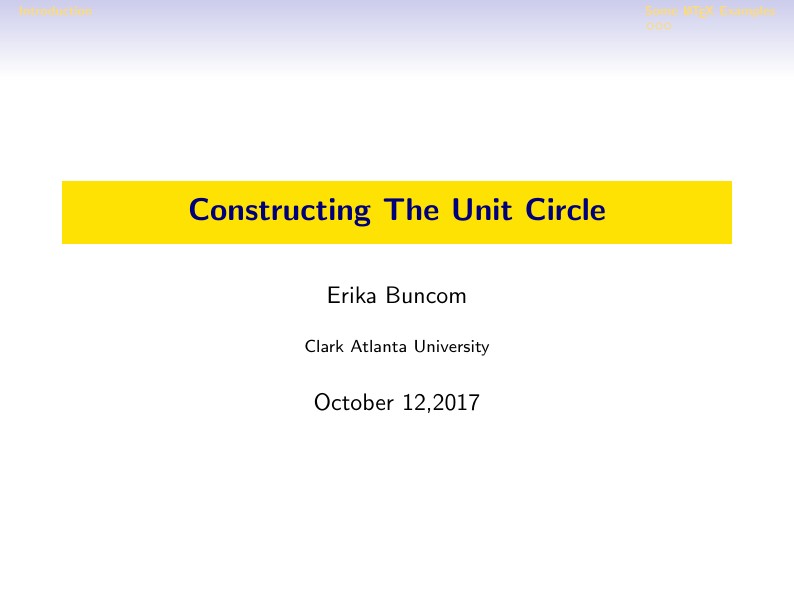
(A Talk) A brief overview of techniques to understand and remember the unit circle

\documentclass{beamer}
\usepackage{textcomp}
%
% Choose how your presentation looks.
%
% For more themes, color themes and font themes, see:
% http://deic.uab.es/~iblanes/beamer_gallery/index_by_theme.html
%
\mode<presentation>
{
\usetheme{Singapore} % or try Darmstadt, Madrid, Warsaw, ...
\usecolortheme{wolverine} % or try albatross, beaver, crane, ...
\usefonttheme{structurebold} % or try serif, structurebold, ...
\setbeamertemplate{navigation symbols}{}
\setbeamertemplate{caption}[numbered]
}
\usepackage[english]{babel}
\usepackage[utf8x]{inputenc}
\title[Constructing The Unit Circle]{Constructing The Unit Circle}
\author{Erika Buncom}
\institute{Clark Atlanta University}
\date{October 12,2017}
\begin{document}
\begin{frame}
\titlepage
\end{frame}
% Uncomment these lines for an automatically generated outline.
%\begin{frame}{Outline}
% \tableofcontents
%\end{frame}
\section{Introduction}
\begin{frame}{Overview}
\begin{itemize}
\item What the Unit Circle is
\item How Degrees and Radians relate
\item Finding Radians and Coordinates
\item How Trigonometric functions relate to the unit circle
% \item Use \texttt{itemize} to organize your main points.
\end{itemize}
\end{frame}
\section{Some \LaTeX{} Examples}
\subsection{Unit Circle}
\begin{frame}{What Is The Unit Circle}
We have a blank graph with four empty quadrants. If I apply this special equation, x\textsuperscript{2}+y\textsuperscript{2}=1, we get a circle of $360$\textdegree with radius 1. A Fun fact is that if we measure the distance from the origin to any point on the circle, the radius is 1. If we take that same radius and detach and curve it, duplicating it three times will give us almost the full distance around a single hemisphere of this circle. After performing a few calculations, we can see that the space missing in between the midway mark on the unit circle and where our set of curves end is approximately 0.14 units long. Thus it is safe to say that it takes 3.14 units to complete a full hemisphere. Which implies that it will take 2 revolutions of Pi measures to travel around the entire unit circle.
%\begin{itemize}
%\item Use \texttt{tabular} for basic tables --- see Table~\ref{tab:widgets}, for example.
%\item You can upload a figure (JPEG, PNG or PDF) using the files menu.
%\item To include it in your document, use the \texttt{includegraphics} command (see the comment below in the source code).
%\end{itemize}
% Commands to include a figure:
%\begin{figure}
%\includegraphics[width=\textwidth]{your-figure's-file-name}
%\caption{\label{fig:your-figure}Caption goes here.}
%\end{figure}
%\begin{table}
%\centering
%\begin{tabular}{l|r}
%Item & Quantity \\\hline
%Widgets & 42 \\
%Gadgets & 13
%\end{tabular}
%\caption{\label{tab:widgets}An example table.}
%\end{table}
\end{frame}
\begin{frame}{What Is The Unit Circle}
Since we know that the distance around the unit circle is $360$\textdegree and that is the equivalent to 2 Pi, If we were to divide $360$\textdegree by 2 we will have $180$\textdegree. If we divide $180$\textdegree by 2 we will have $90$\textdegree as well as $270$\textdegree, being a midpoint between $180$\textdegree and $360$\textdegree.
\end{frame}
\begin{frame}{How Degrees and Radians Relate}
\begin{itemize}
\item In order to get accurate radian measures, we must convert our degrees. Using our (Degrees/180)(Pi). If we wanted to go from radians back to degrees, we would simply use our (Radians/Pi)(180).
\item What is positive in each quadrant:
\item All trig functions are positive
\item Sine is positive in the second quadrant
\item Tangent is positive in the third quadrant
\item Cosine is positive in the fourth quadrant
\end{itemize}
\end{frame}
\end{document}